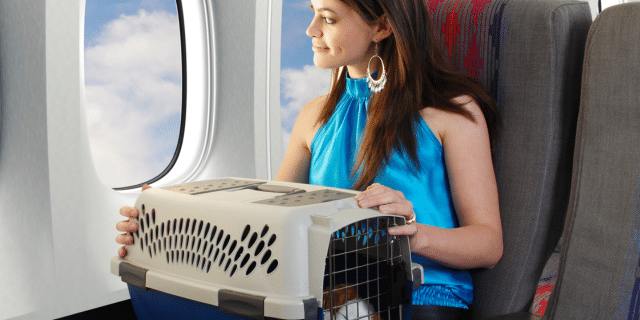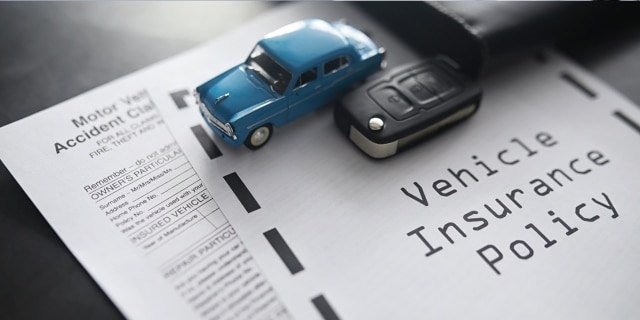
by California Casualty | Auto Insurance Info, Safety |
There’s nothing quite like prom and graduation season—the photos, the dresses and tuxes, the flowers, the celebrations. But while your teen may be focused on finding the perfect outfit or planning the after party, you’re likely thinking about something else entirely: their safety on the road.
Here are some tips to help your teen navigate prom, graduation, and all the celebrations in between—safely.
1. Make “leaving early” a habit.
Encourage your teen to leave at least 10 minutes earlier than needed—more if weather conditions are poor. This reduces the urge to speed and gives them time to react calmly to traffic or detours. If they’re heading to the same event as many others, they might also encounter fewer cars and pedestrians if they beat the rush.
2. Limit passengers.
It’s fun to pile into a car with friends, but the more people you have, the more distractions the driver encounters. Set limits on how many friends can ride with your teen and remind them that safety comes before socializing.
3. Always buckle up.
Seat belts are simple but lifesaving. Make sure your teen—and everyone in their car—buckles up before the engine starts. Reinforce the message that seat belts are non-negotiable, even for short trips.
4. Phones down, eyes up.
Phones are one of the biggest distractions for drivers, especially teens. Talk with your teen about putting their phone away while driving. There are apps that can silence notifications, send automatic replies, and even block texts while the car is in motion. Sharing their location with you is also a smart move in case you need to reach them in an emergency.
5. Minimize all distractions.
Texting isn’t the only distraction. Eating, drinking, adjusting the music, or checking makeup can all take attention off the road. Remind your teen to stay focused and wait until they’re parked to multitask.
6. Don’t drive while drowsy.
With finals, late-night celebrations, and packed schedules, your teen may not be getting enough sleep. Driving tired is just as dangerous as driving under the influence. If they feel themselves nodding off, they should pull over in a safe place and rest before continuing.
7. No drinking and driving—ever.
This one may seem obvious, but it bears repeating. Teens should never get behind the wheel after drinking or using any substance. Have an open conversation about peer pressure and agree on a “safe word” they can use if they need you to pick them up—no questions asked.
8. Keep an emergency kit in the car.
Whether it’s a flat tire, dead battery, or a minor fender bender, your teen should know what to do in case of a car emergency. Pack a basic kit with a flashlight, jumper cables, water, a first-aid kit, and emergency contact numbers. Make sure they know how to use everything in it. Teach your teen basic vehicle care and warning signs.
9. Be accident-ready, just in case.
Teens are often accident-prone because of their inexperience behind the wheel. Make sure your teen knows what to do if they’re ever in a crash. Go over the basics together: stay calm, check for injuries, move to safety, call 911, and exchange information with the other driver. Keeping an emergency kit in the car and insurance details in the glove box can also help them feel more prepared and confident.
10. Set a curfew.
More than 40% of fatal crashes involving young drivers happen between 9 p.m. and 6 a.m. It’s not just the challenge of driving in the dark—late-night trips are often social outings where distractions and peer pressure can run high. Even rule-following teens can be tempted to take risks. Setting an earlier curfew than your state requires can help keep your teen safer. Bonus: Offer to drive them and pick them up for late night outings.
11. Control the keys.
When teens have to ask for the car, it naturally opens the door for conversation. It’s a built-in pause that gives parents a moment to check in—about where they’re headed, who they’ll be with, and when they plan to return. It’s also a subtle reminder that driving is a privilege, not a right, and that responsibility comes with it. Keeping the keys in your hands helps reinforce expectations and encourages accountability.
12. Monitor risky behavior.
Consider a monitoring device or app that can track risky behaviors such as speeding, abrupt acceleration and sudden braking. You can also keep tabs on your teen’s location with GPS tracking. Some systems have a silent alarm so your teen can signal SOS if they feel unsafe.
Finally, this is a good time to review your insurance. Is your teen properly covered? Have you discussed all the ways you can save with a teen driver? Ensuring your policy is up to date can give both of you peace of mind during this high-risk season.
Prom and graduation are once-in-a-lifetime milestones, and you want your teen to enjoy them to the fullest—safely. Start the conversation early, model safe driving behavior yourself, and let them know you’re always just a phone call away. Your guidance and trust go a long way in helping them make smart decisions behind the wheel.
This article is furnished by California Casualty, providing auto and home insurance to educators, law enforcement officers, firefighters, and nurses. Get a quote at 1.866.704.8614 or www.calcas.com.

by California Casualty | Pets, Travel |
Whether your pet is a seasoned jetsetter or a first-time flyer, navigating air travel with a four-legged friend takes planning, patience, and know-how. From booking the right seat to ensuring a smooth security check, here’s how to make flying with your pet a paws-itively stress-free adventure!
Cabin or Cargo? Choosing the Best Travel Option
Your pet’s size will determine whether they can fly in the cabin with you or if they must go in cargo. Cargo is not for every pet, and if you must consider it, make sure to check with your vet that it is safe for your pet’s breed, age and health.
Carry-On Pets:
- Pets in the plane’s cabin are limited to cats and small dogs meeting size requirements.
- Your pet must remain in a carrier under the seat in front of you for the flight.
- Some airlines allow you to purchase an extra seat for your pet carrier. You still will need to keep your pet in the carrier, and you also will need to place the carrier under the seat during takeoff and landing.
- Choose a window or aisle seat which will have the most room to stow your pet’s carrier under the seat. Avoid emergency exit rows and bulkhead seats.
- A pet fee applies. Check with the airline for the exact amount.
Cargo Travel:
- Larger dogs must fly in cargo, which is the space at the bottom of the plane where luggage is stored.
- While cargo is ventilated, it is not temperature controlled, and airflow is not the same as in the cabin. Pets may not be allowed in cargo during extreme heat or cold.
- Short-nosed breeds like bulldogs, pugs, and Persian cats are at higher risk for breathing issues and should never fly in cargo.
- Pets must be placed in cargo-approved kennels. Check your airline for specifications.
- While most pets travel safely in cargo, poor ventilation or mishandling can pose risks.
- Most airlines are required to report on companion animal safety. Check your airline’s safety record before booking your pet in cargo.
- A pet fee also applies.
Service Dogs:
- Service dogs are an exception to the pet traveling policies. They are allowed to be out of a carrier but must not block the aisle. Generally, they are not allowed on seats.
- To qualify as a service dog, they must be fully trained and certified to assist a person with a disability.
- Emotional support animals are considered pets and not service dogs. They must follow standard pet travel guidelines.
- Service dogs will usually fly free of charge.
Booking Your Flight
- Research quarantine, vaccine, and other restrictions for your destination so you will have the right paperwork.
- Always communicate with the airline in advance. You don’t want any surprises.
- Book direct flights. There is less chance of handoffs going wrong.
- For cargo, if traveling in the summer, pick early morning or evening flights to avoid the hottest parts of the day. In winter, book midday flights to avoid the cold.
Prepping Your Pet for Takeoff
Before your trip, make sure your pet is in tip-top shape for travel. Here’s how:
- Vet Visit: Schedule a checkup to ensure your pet is healthy enough to fly. Some destinations require a health certificate issued within 10 days of travel.
- Skip Sedatives: Tranquilizers can affect breathing. Ask your vet for guidance on whether you should use them. You also can consider pet calming chews with melatonin or chamomile. For nervous cats, try pheromone sprays to help ease anxiety.
- Microchip & ID: Make sure your pet’s microchip info is up to date and their collar includes both your home address and temporary travel address.
Helping Your Pet Adjust to Air Travel
Crate Training: Get your pet comfortable with their travel carrier well in advance. Reward them with treats and praise.
- Crowd Exposure: Airports are busy and noisy! Take your dog to a crowded, dog-friendly area to get them used to similar sights and sounds.
- Practice Security Checks: TSA requires pets to go through security outside of their carrier. Practice taking your pet in and out calmly.
Packing List: Don’t Forget These Essentials
Proof of vaccinations and vet contact info
- Microchip number and pet license
- Airline-approved carrier (waterproof & spacious enough for your pet to stand, turn, and lie down)
- Collapsible water bowl
- Small bag of food in case of delays
- Treats and chew toy (helps with pressure changes)
- Poop bags and pet wipes for clean-ups
- Extra collar and leash
- A recent photo of your pet (for ID purposes)
Pro Tip: For pets traveling in cargo, freeze water in the collapsible water bowl. This will help prevent spills. By the time your pet is thirsty, the water will have defrosted. You can also attach a water bottle dispenser.
Airport Tips: Navigating the Terminal with Your Pet
Strange sounds, sights and smells can be challenging even for the most well-trained pet. Changes in diet and water also can affect your pet. Here are some ways to navigate specific issues with traveling.
Skip Breakfast? A light stomach may help prevent nausea—check with your vet.
- Pre-Flight Potty Break: Ensure your pet relieves themselves before heading to check-in.
- Cargo Flyers: Label crates with LIVE ANIMAL in large letters and add arrows to indicate the upright position. Attach a photo of your pet, and line the bottom with towels. This will help absorb any liquids if there are accidents. You will be dropping off your pet at the check-in counter along with your luggage.
- Cabin Flyers: Be prepared to remove your pet from the carrier for TSA screening. Once through security, locate pet relief areas before boarding.
- Alert the Flight Crew: If your pet is traveling in cargo, notify a flight attendant so they’re aware. They should be able to confirm that your pet is safely on board.
- Meet Your Pet: The airline will direct you to a place where you can meet your pet and show them some love following your flight.
Are you flying with small children, too? Check out our blog on Flying with Kids.
Travel with Peace of Mind
Finally, don’t forget to protect your fur baby with pet insurance for added peace of mind, and to save on your vet bill. Remember, you can easily add pet insurance from Pet’s Best to your California Casualty auto or home policy. Find out more about what pet insurance can cover by talking with a California Casualty customer service representative today.
This article is furnished by California Casualty, providing auto and home insurance to educators, law enforcement officers, firefighters, and nurses. Get a quote at 1.866.704.8614 or www.calcas.com.

by California Casualty | Auto Insurance Info, Safety |
We’ve all seen it—or maybe even been guilty of it ourselves. A quick glance at a text, adjusting the GPS, or sipping that morning coffee behind the wheel. Distracted driving is a dangerous habit that can have devastating consequences. But what exactly is distracted driving, and how can we break the cycle?
What Is Distracted Driving?
Distracted driving is any activity that takes your attention away from the road. It’s often associated with texting or talking on the phone, but it also includes:
- Eating or drinking
- Adjusting the radio or GPS
- Using electronic gadgets
- Personal grooming
- Tending to Rover or Kitty
- Daydreaming or zoning out
Distractions come in three forms:
- Visual – Taking your eyes off the road
- Physical – Taking one or both hands off the wheel
- Cognitive – Mental distractions that shift your focus away from driving
Many distracted driving habits involve one or more of these forms, but using a cell phone or electronic device is especially dangerous because it engages all three at once.
The Science Behind Distracted Driving
Driving demands our full attention, yet many of us still text, call, or use electronic devices behind the wheel. Why do we do it, even when we know it’s dangerous? One reason is that our brains crave the small dopamine boost we get from checking messages—almost like a drug, it can override our sense of risk. We may also feel pressure to respond quickly to work or friends. And often, we overestimate our ability to multitask, believing we can manage both driving and distractions.
However, the reality is that multitasking behind the wheel is dangerous. Studies show that even hands-free phone use can cause “inattentional blindness,” where drivers fail to notice crucial details like stop signs or pedestrians. Distracted driving significantly delays your reaction time.
When attention is split, the brain struggles to process different tasks efficiently, increasing the risk of an accident. Staying fully present while driving isn’t just a good habit—it’s a necessity.
The Impact: Alarming Statistics
Research suggests that sending or reading a text takes your eyes off the road for about five seconds—long enough to travel the length of a football field at highway speeds. That’s a terrifying thought. Think of what could happen while driving that distance at that speed if you’re not paying attention.
More statistics paint a grim picture of distracted driving’s consequences:
- In 2022, over 3,300 people in the U.S. lost their lives and nearly 290,000 people were injured in crashes involving distracted drivers.
- About 1 in 5 people killed in these crashes were not in vehicles—they were pedestrians, cyclists, or bystanders.
- Texting while driving increases your crash risk by 23 times compared to driving undistracted. It can double or even triple your reaction time.
- Talking on the phone increases risk of a crash by 4 to 6 times.
- Cell phone use while driving is comparable to driving under the influence.
These statistics are sobering, but the good news is that distracted driving is preventable.
Laws to Keep Drivers Safe
Today’s cell phones and electronic devices allow us to scroll through social media, watch videos, stream music, take photos, and more. That increases our chances to be allured by distracted driving. To combat this growing problem, many states have implemented strict laws, particularly against electronic devices. These include:
- Handheld device bans – Prohibiting texting or holding a phone while driving
- Hands-free laws – Requiring drivers to use voice commands or Bluetooth systems
- Teen driver restrictions – Limiting phone use for young drivers, who are at higher risk
Currently 16 states ban drivers from holding electronic devices. There are 34 states and DC that ban teens from electronic device use, including hands-free use. Fines and penalties for violations are becoming more severe, reinforcing the message that distracted driving is not worth the risk.
How to Break the Habit
Stopping distracted driving starts with personal responsibility. You can take the steps needed to break the habit. Here are some strategies that can help you to stay focused behind the wheel:
- Put your phone away. Keep it in the glove compartment or enable “Do Not Disturb” mode while driving or try one of the many safe driving apps available to minimize distractions. Some apps even “pay” you to drive with your phone locked down. You earn points toward discounts and coupons.
- Plan ahead. Set your GPS, load your playlist, and adjust climate controls before you start driving. Make sure your children and pets are securely seated for the ride.
- Designate a “co-pilot.” Let them adjust audio, GPS or other settings for you. You can ask them to respond to texts as needed.
- Use voice commands. If you must take a phone call, use a hands-free system.
- Pull over if needed. If something requires your full attention, find a safe place to stop.
- Suggest a distracted driving policy for work. Talk to your employer about setting a policy that allows work calls or texts to wait until you are safely parked.
- Avoid reaching. If something falls while driving, don’t reach for it. Either ask a passenger to do so, wait until you’re parked to get it, or pull over safely before you reach.
- Model good behavior. Your passengers are noticing, and so are your kids. Teen drivers often inherit their parents’ driving habits. Remind them, and yourself, why you are doing this. Take the National Highway Traffic Safety Administration Pledge to reinforce your commitment.
Distracted driving is a preventable danger. By understanding the risks, following the laws, and making a conscious effort to stay focused, we can all do our part to keep the roads safer. Breaking the habit starts with a single decision—choosing to prioritize safety over distractions. Safe travels.
This article is furnished by California Casualty, providing auto and home insurance to educators, law enforcement officers, firefighters, and nurses. Get a quote at 1.866.704.8614 or www.calcas.com.

by California Casualty | Auto Insurance Info, Helpful Tips, Safety |
Age may bring wisdom, but it also comes with new challenges behind the wheel. From adapting to changing reflexes to navigating the latest technology in cars, senior drivers face unique hurdles. If you are a senior driver, or know one, here are simple tips to help stay safe and confident on the road.
How does age affect your driving?
As we get older, changes in our bodies can affect how safely we drive. Stiff joints, muscle weakness, or arthritis can make it harder to turn your head, press the brakes, or react quickly in traffic. If you’ve lost some feeling in your fingers or feet, it might slow down your reaction time or make it harder to stay in control of the car. Vision changes can make it tough to see at night or read road signs quickly, and hearing loss might mean you don’t notice important sounds like sirens or horns. On top of that, some medications can cause drowsiness, dizziness, or slower reactions, which can all affect your driving.
Tip #1: Stay on top of your health.
- Regularly check your vision, hearing, and mobility to ensure they’re not affecting your ability to drive safely. Minimize distractions, such as loud music or other sounds, to help you hear important traffic cues like horns or sirens.
- If you have limited mobility, consider vehicle modifications. For example, hand controls can replace traditional gas and brake pedals if leg movement is a challenge. Consult with your doctor and an occupational therapist to explore your options.
- Be mindful of how medications impact driving. Avoid driving if you’re taking anything that causes drowsiness or lightheadedness.
Tip #2: Make sure your car is the right fit for you.
- If it’s an option, select larger dials and easy to read symbols on your car’s dashboard. Turn brightness up on your instrument panel so it is easy to see.
- Adjust your seat so you’re not sitting closer than 10 inches to the steering wheel. Make sure your feet can easily press the pedals, without your having to reach with your toes. Pedal extensions are available for those who need it.
- Check out the CarFit program sponsored by AAA, AARP Driver Safety, and AOTA (American Occupational Therapy Association). This program can help educate you on ways you can make your car more comfortable and safer as you age.
Tip #3: Understand your car’s safety technology.
- Check your owner’s manual to determine the advanced safety technologies in your vehicle. This may include blind spot monitoring, automatic braking, lane-keeping assist, rearview camera, automatic crash notification, navigation, and more.
- Seek help from tech-savvy family or friends who can explain features and help you practice. Watch online tutorials—many car manufacturers offer easy-to-follow videos on their websites or YouTube channels. You can also ask your dealer for a demonstration when servicing your car.
- If new tech seems overwhelming, take it slow. Practice one new feature at a time to get comfortable with it. Start with the safety features like blind spot monitors. Don’t get discouraged as it can take time to learn new technology.
Tip #4: Drive safely and defensively.
- Maintain a safe following distance. Avoid tailgating and give yourself plenty of space to react to sudden stops or changes in traffic. This is especially important in bad weather or heavy traffic.
- Drive at a comfortable speed. Stick to the speed limit and, if you prefer driving slower, stay in the right lane to let faster traffic pass safely.
- Stay focused and alert. Avoid distractions like using your phone, eating, or multitasking while driving. Never drink and drive and be mindful of any medications that might impair your ability to focus.
Tip #5: Avoid driving certain times of the day or night.
- If driving at night feels difficult or uncomfortable, try to avoid it. Similarly, be cautious around sunrise and sunset when glare from the sun can impact your visibility.
- Refrain from driving when you’re stressed, tired, or not feeling alert. Skip rush hour or heavy traffic areas to reduce stress and risk.
- Avoid driving in rain, snow, ice, or other challenging weather conditions. Consider using rideshare services, public transportation, or asking for a ride from friends or family during these times.
Tip #6: Know how to deal with night driving.
- Make sure your headlights, taillights, windshield and side windows are clean.
- Allow for more space between you and the car in front to allow for additional stopping room – it’s harder to judge speed and distance in the dark.
- If headlights of oncoming vehicles are too bright, look down and to the right. It will help deflect the light and you can use the right side of the road as your guide.
- Do not wear sunglasses or tinted lenses at night. It reduces the amount of light that reaches your eyes and can make driving hazardous.
Tip #7: Take advantage of available support.
- Refresh your knowledge of driving rules with a program like AAA’s RoadWise Driver Course. Completing the course may even qualify you for a discount with certain insurance providers.
- Consider hiring a driving rehabilitation specialist. These professionals assess key factors such as muscle strength, flexibility, reaction time, and decision-making skills to help ensure safe driving.
- Talk to trusted friends and family about your driving. Their honest feedback and support can help you identify areas for improvement and give you confidence behind the wheel.
Tip #8: Is it time to stop driving? Know the warning signs.
- Be alert for warning signs such as multiple accidents, near-misses, or new scrapes and dents on the vehicle. Pay attention if you have received two or more tickets or warnings within the past two years.
- Watch for signs of erratic, unsafe, or aggressive driving from your loved one, or if you’re the driver, for times you felt out of control.
- Take seriously any recommendation from a doctor to change driving habits or stop driving altogether.
- Approach the conversation with your loved one with empathy, focusing on positivity and support. Together, you can explore alternative ways to maintain their freedom and connection to the world around them.
Finally, make sure your car is fully protected for added peace of mind. Safe travels.
This article is furnished by California Casualty, providing auto and home insurance to educators, law enforcement officers, firefighters, and nurses. Get a quote at 1.866.704.8614 or www.calcas.com.

by California Casualty | Auto Insurance Info, News |
Imagine getting into a fender bender and realizing your insurance won’t fully cover the damages. With rising medical costs and repair expenses, California is making its first major update to auto insurance requirements in over 50 years. Starting January 1, 2025, new higher minimum liability limits will better protect drivers from unexpected financial burdens. But what do these changes mean for you? Let’s break it down.
Understanding Liability Coverage
Liability insurance helps cover damages if you cause an accident. It does not cover your own injuries or vehicle damage—that’s where collision and comprehensive coverage come in.
Because accidents can lead to costly damages, liability insurance is required by law in most states to protect victims of accidents. It consists of two parts:
- Bodily Injury Coverage – Pays for medical expenses, lost wages, and pain and suffering for the other driver and passengers.
- Property Damage Coverage – Pays for repairs or replacement of the other vehicle or damaged property, such as a fence or building.
Why Coverage Limits Matter
When you buy liability insurance, you choose a coverage limit. If the costs of an accident exceed your limit, you’ll have to pay the difference out of pocket. For example, if your policy covers $50,000 per person, but the injured driver’s medical bills total $60,000, you would be responsible for the extra $10,000.
The main goal of liability insurance is to protect your assets, and so you may choose a higher limit than the state specifies. You’ll want to take into account the amount of medical expenses that could be incurred in an accident. You could be responsible for lost wages for the driver. If tragically he or she dies, you could be providing lost wages for the driver’s family.
On the other hand, if you’re the victim of an accident and the at-fault driver has higher liability limits, their insurance will be better equipped to cover your medical expenses and property damage. So, that’s good news.
What’s Changing in 2025?
California’s previous minimum coverage limits—set in 1967—were among the lowest in the nation. The costs of medical car and car repairs have increased substantially since that time. The new limits under Senate Bill 1107 (the Protect California Drivers Act) increase the minimum amount of coverage to align more closely with today’s costs. They seek to reduce the financial burden on crash victims.
Effective, January 1, 2025, the new limits are as follows:
- $30,000 for injury or death to one person (previously $15,000)
- $60,000 for injury or death to multiple people (previously $30,000)
- $15,000 for property damage (previously $5,000)
While increasing liability limits provides better financial protection, it can also lead to a slight rise in premiums, especially for those who currently have only the minimum required coverage. However, this added cost is often minimal compared to the potential financial burden of an accident that exceeds your policy limits.
Time to Review Your Auto Policy
With these new requirements, now is the perfect time to review your auto coverage. While many insurance companies will automatically update your policy if you reside in California, you’ll want to make sure the new limits are in place. After all, failing to meet the new minimums could result in:
- Legal penalties, fines, impoundment of your vehicle, or suspension of your driver’s license and/or registration
- Out-of-pocket expenses for medical bills, property damage, and legal fees
How to Save on Coverage
Higher limits don’t always mean higher costs. At California Casualty, we offer package discounts and savings for customers carrying higher coverage levels. Additional discounts may apply if you:
- Are a member of an eligible group (educators, nurses, first responders, firefighters and law enforcement);
- Bundle home and auto insurance;
- Take a driver safety course; and/or
- Maintain a good insurance score known as the Financial Responsibility (FR) Score.
Knowing what affects your car insurance rate can help you make changes to reduce the amount you pay while still getting great coverage. Learn more about your options and get a free quote today.
This article is furnished by California Casualty, providing auto and home insurance to educators, law enforcement officers, firefighters, and nurses. Get a quote at 1.866.704.8614 or www.calcas.com.





